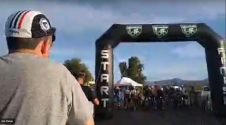2022 6-12-24 World Time Trial Championship race report
I’m a relative newbie to ultras. My first race was the 6-hour at the 6-12-24 World Time Trial Championship in Borrego Springs in 2019. I followed that up with the 12-hour in 2021, and the 12-hour at Bike Sebring earlier this year. To challenge myself further, I decided to step it up this year and enter the 24-hour race at Borrego Springs.
Since I had never raced nor ridden so long, I made sure I was well-prepared. I wrote a manual for my crew to lessen their stress and confusion about what I would need when. The week before departing I created a checklist that ultimately had 151 items including everything I needed to do before we departed, everything I needed to do once we arrived, and all of the tools, supplies, hydration, fuel, kit, street clothes, electronics, and other items we would need. The final items in the list were the things I needed to do on race day, and the last item was “start”. Here’s a photo of our Subaru loaded with all of the stuff.
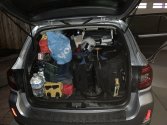
I used the same Bright Eyes headlamp as the last two races, but used two 10.4 Ah batteries connected with a splitter. I tested this configuration to make sure it would last 14 hours on the medium setting (1200 lumens). I also procured a Terrano communication system, suggested by Jeffrey Ritter, so that I would avoid the communication errors that caused pit stop delays last year and pit stop stress at Bike Sebring.
I came into the race in peak fitness. Training rides over the past three months included two California Triple Crown double centuries, one group century, and seven solo centuries. In the month before the race I set my all-time peak power on Training Peaks for 5-minute, 60-minute, and 90-minute intervals, aided by a strength training program that included back squats, trap bar deadlifts, leg lifts, hamstring curls, and calf raises.
My plan was to start off in my base layer and swap to warmer clothes when my hydration ran out. I carried a 3.75L hydration bladder filled with salted-up Roctane mix in a Bacchetta Brain Box and clear water in a 0.5L time trial bottle up front. I brought two Brain Boxes so that we could swap them quickly, like giant water bottles. I also wore a Nathan running belt stocked with peanut butter and honey sandwich quarters, Clif Bar quarters, Sweetarts, caffeine capsules, and Roctane gels.
When the race started my bike computer was reading a comfortable 75F. I started in wave #3 with most of the other recumbents, and quickly moved to second position in the wave behind a guy who started off with a sprint like he was doing a Zwift race. I tried to keep my power near the upper end of the starting range that my coach suggested, though I had to crank it up from time to time as I made my way through the traffic of wave #2 and wave #1. There were still a couple of groups clogging the lane on the second lap, but after that everyone was in single file. Here are a couple photos, one at the start and the other early in the race entering the timing lane.
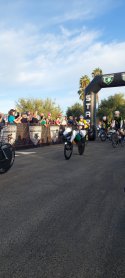
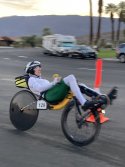
After the sun went down during Lap 2, I raised the shield on my helmet at stowed it inverted above my brow on the helmet. The temperature dropped quickly, and I started to get cold. I was concerned that I’d have to stop early for clothes. But once my sweat dried, I became comfortable again.
On lap 3 as I approached the zig-zag turn on the north side (Henderson Canyon, Di Giorgio, Henerson Canyon) I was having a lot of trouble seeing the turn. They place cones along the centerline of Di Giorgio between the two Henderson Canyon sections which helps with spotting the turn at night. I slowed down as I approached where I expected it to be and could see the turn, but didn’t see any cones. After making the right I could see the last cone laying on its side in my lane. After making the left onto Henderson Canyon, I called Elisa to ask her to let the Race Director know that most of the cones had gone missing. The next time around, all of the cones were there along with a car parked on the opposite side of Di Giorgio with its lights on.
Somewhere around Lap 3 or Lap 4 I started seeing strange distortions to my left, but when I would look that way everything was fine. I closed my right eye and discovered that the vision in my left eye was strangely distorted. I figured I must have got something on the left lens of my glasses, so I wiped it with the back of my glove. No change. So then I figured it must be my contact lens. I figured that I must have put it in backwards, or maybe it tore or slipped out of position. It was annoying but tolerable, so I figured I’d deal with it later at a pit stop.
A little past midnight as I was descending into Christmas Circle from the incline my hydration bladder went dry. I still had the TT bottle, and the air was cold so I wouldn’t need to drink much, so I decided to take another lap. By the time I got back around to the pit area for my first stop it was 1am. My bike computer was reading 39F and my hands were so cold that I had trouble handling the TT bottle.
My core was warm, so I just added upper body clothing to get my hands and arms warmed up: autumn race-fit long-sleeve jersey, winter sleeves, and full-fingered gloves. It turns out that wasn’t enough, so at 3:30am I came in again and added knee-high socks, race-fit pants, and a thin beanie under my helmet.
At just after 6am I was approaching the northeast corner of the course where we would turn from Henderson Canyon Road onto Borrego Valley Road. There were three racers in front of me, and I easily overtook third wheel. I had to decide to either wait behind second wheel or pass, so I applied extra power and went by second wheel. Every other time I went around this turn my strategy was to look for the turn on my bike computer trace, then as I approached, look for the stop line for northbound Borrego Valley Road and use it as a marker to take a wide turn. I did this because it was hard for me to see the difference between the tarmac and the sand in the apex. But this time I watched the line of the racer in front of me and tried to take it. As I got into the turn I realized that I had cut it too close and crashed in the sand. Fortunately, it was soft sand and there was no damage to me or to my bike. The racers behind me stopped to make sure I was OK, and after checking everything quickly I was off again in less that 60 seconds. Here’s a photo of the corner showing a line that some bike, maybe mine, took through the sand.
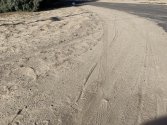
On the next lap the sky was starting to get light. On the backstretch I checked my left eye again, and to my horror the only thing I could see was light! There were no distorted features. I thought to myself “well, I guess it’s time to get that contact lens out of there.” I called Elisa and let her know what was going on and that I would be coming in to remove the contact lens. I pulled through the pit area and removed the contact lens quickly. To my additional horror my vision was still severely clouded. It was like looking through a fogged-up windshield in a car. We rinsed my eye with water, but no change. Then Ben Tomblin went to get some eye drops, and we put those in. There was no immediate change. I asked Elisa to go tell the Race Director that I would be pausing for a bit. After 20 minutes, there was still no change, so I decided at that point to drop out. At this point I figured my vision was probably a factor in the crash, and I didn’t want to tempt fate. We returned to that corner the next day, and there is a ridge of even deeper sand well inside the apex. I suspect that in the moment with compromised vision I mistook that ridge for the edge of the tarmac.
The EMT at the race came over and checked me out. She put more drops in my eye, put a patch over the eye, and recommended that I see my eye doctor as soon as I got home. I went back to the hotel, ate some food and took a nap. When I woke from the nap my vision had recovered.
On the drive home the next day, I searched online for “ultra cycling foggy vision” and found this article:
https://www.irunfar.com/vision-loss-in-ultramarathons-looking-at-the-research. Searching later, I also found these:
https://eyewiki.aao.org/Ultramarathon-induced_Corneal_Edema and
https://pubmed.ncbi.nlm.nih.gov/25728559/. I saw my eye doctor on Monday, and everything checked out fine. I discussed corneal edema and some of the findings in the articles with her, and she agreed that corneal edema is a plausible explanation for what happened.
Thanks to my wife Elisa and my son Conrad for crewing. Thanks to Nate English for his expert coaching. Thanks to Jim Parker and Ben Tomblin for helping at the end with my eyes. Thanks to the EMT for her expert medical attention. And thanks to the racers who stopped their race to make sure I was OK after I crashed.
Next time I’ll have more items on my checklist: goggles and 5% hypertonic saline eye drops. And the last item on my checklist will be “finish”.

